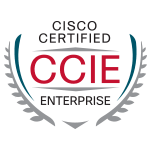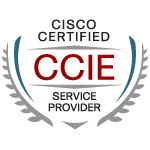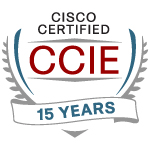Understanding Cisco Cybersecurity Operations Fundamentals (CBROPS) Course + Exam
Understanding Cisco Cybersecurity Operations Fundamentals (CBROPS) Certification
Cisco has specially designed the 200-201 CBROPS Understanding Cisco Cybersecurity Operations Fundamentals certification training course for professionals looking to start a career in cybersecurity professionals.
The 200-201 CBROPS Understanding Cisco Cybersecurity Operations Fundamentals certification training course to learn skills in security algorithms, methods, and techniques to add improve data security within the organisation. This course is a combination of Cybersecurity Fundamentals and Cybersecurity Operations. This certification helps to enhance your skills in cybersecurity and develop capabilities in security concepts, security monitoring, host-based analysis, network intrusion analysis and security policies and procedures.
Cybersecurity jobs are growing rapidly and there is a shortage of cybersecurity positions, this certification will help you to move forward in your career.
Upon the CBROPS Understanding Cisco Cybersecurity Operations Fundamentals training course completion, participants can attempt the 200-201 certification exam to get Cisco Certified CyberOps Associate certified.
Logitrain offers Understanding Cisco Cybersecurity Operations Fundamentals 200-201 certification training course in Melbourne, Sydney, Brisbane, Adelaide, Perth, Canberra, in-house and live online.
- Training: get practical technical skills
- Receive a certificate of course attendance
- Small class size: increased instructor interaction
- Authorised test center: exams taken at our premises
- Expert trainers: imparting real world experience
Candidates can achieve this certification by passing the following exam(s).
- 200-201 – CBROPS (Cisco Cybersecurity Operations and Fundamentals)
The certification exam can be registered and attempted within 3 months of course/module completion at Logitrain training centre on weekdays during normal business hours (excludes public holidays)
CBROPS course material
- Explain how a Security Operations Center (SOC) operates and describe the different types of services that are performed from a Tier 1 SOC analyst’s perspective.
- Explain Network Security Monitoring (NSM) tools that are available to the network security analyst.
- Explain the data that is available to the network security analyst.
- Describe the basic concepts and uses of cryptography.
- Describe security flaws in the TCP/IP protocol and how they can be used to attack networks and hosts.
- Understand common endpoint security technologies.
- Understand the kill chain and the diamond models for incident investigations, and the use of exploit kits by threat actors.
- Identify resources for hunting cyber threats.
- Explain the need for event data normalization and event correlation.
- Identify the common attack vectors.
- Identify malicious activities.
- Identify patterns of suspicious behaviors.
- Conduct security incident investigations.
- Explain the use of a typical playbook in the SOC.
- Explain the use of SOC metrics to measure the effectiveness of the SOC.
- Explain the use of a workflow management system and automation to improve the effectiveness of the SOC.
- Describe a typical incident response plan and the functions of a typical Computer Security Incident Response Team (CSIRT).
- Explain the use of Vocabulary for Event Recording and Incident Sharing (VERIS) to document security incidents in a standard format.
This course is likely to add to the employment related skills of the participants. The skills developed are likely to be used in the course of being an employee or working in a business.
- IT Security Engineer
- IT Security Consultant
- Security Systems Administrator
- Security Architect
- Cryptographer
- Information Security Analyst
- Penetration Tester
- Candidates preparing for the CyberOps certification
- Create structured addressing plans for IPv4 and IPv6
- Create stable, secure, and scalable routing designs for IS-IS
- Create stable, secure, and scalable routing designs for EIGRP
- Create stable, secure, and scalable routing designs for OSPF
- Create stable, secure, and scalable routing designs for BGP
- Determine IPv6 migration strategies
- Design campus networks for high availability
- Design campus Layer 2 infrastructures
- Design multicampus Layer 3 infrastructures
- Describe SD-Access Architecture (underlay, overlay, control and data plane, automation, wireless, and security)
- Describe SD-Access fabric design considerations for wired and wireless access (overlay, fabric design, control plan design, border design, segmentation, virtual networks, scalability, over the top and fabric for wireless, multicast)
- Compare WAN connectivity options
- Design site-to-site VPN
- Design high availability for enterprise WAN
- Describe Cisco SD-WAN Architecture (orchestration plane, management plane, control plane, data plane, on-boarding and provisioning, security)
- Describe Cisco SD-WAN design considerations (control plane design, overlay design, LAN design, high availability, redundancy, scalability, security design, QoS and multicast over SD-WAN fabric)
- Select appropriate QoS strategies to meet customer requirements (DiffServ, IntServ)
- Design end-to-end QoS policies
- Design network management techniques
- Describe multicast routing concepts (source trees, shared trees, RPF, rendezvous points)
- Design multicast services (SSM, PIM bidirectional, MSDP)
- Choose the correct YANG data model set based on requirements
- Differentiate between IETF, Openconfig, and Cisco native YANG models
- Differentiate between NETCONF and RESTCONF
- Describe the impact of model-driven telemetry on the network
- Compare dial-in and dial-out approaches to model-driven telemetry
“We have helped thousands achieve Cisco Certifications, let us help you”
– Murad Tanvir, Double CCIE #17081

Take the certification exam within 3 months of course / module completion

Take the official certification exam at Logitrain, a local VUE test centre or online

Course material in digital format is included for flexibility and ease of use

Mock test is included in the full-time courses to assist with your preparation

Our trainers are highly skilled with expertise and extensive hands-on experience

Relax, we will beat competitor’s advertised price. Our course has no extra costs
| Location | Type | Duration | Price | Dates | |
|---|---|---|---|---|---|
| Location | Type | Duration | Price | Dates |
The supply of this course/package/program is governed by our terms and conditions. Please read them carefully before enrolling, as enrolment is conditional on acceptance of these terms and conditions. Proposed course dates are given, course runs subject to availability and minimum registrations.

Find out why we are the leading choice to help boost your career in Australia

“The trainer explained everything very well. Logitrain was very helpful for me in getting a better overall understanding of CCNA. I previously had studied it 2 years earlier but required revision.”
– Felice Amenta, Senior Service Management Officer at Optus, Rating: 4.8/5
“I recently followed the ITIL Foundation course at Logitrain. The training, materials and facilities were excellent and I would not hesitate to train with Logitrain again.”
– Rob Stockey, Senior Engineer at APAC, Rating: 4.8/5
“Had a blast! Great course, will be back soon to do another.”
– Justin Blackford, Systems Administrator at Gloria Jean’s Coffee, Rating: 4.8/5
“The trainer was very patient and gave everybody the opportunity to participate.”
– Tim Symonds, Solutions Architect at MSC Mobility Solutions, Rating: 4.8/5
Over 1000 organisations have relied on Logitrain to be their trusted training partner.


Don’t Wait. Please fill the form now.




